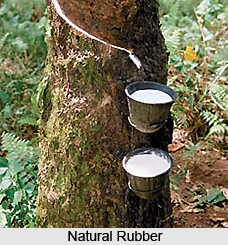 Economy of Kasaragod district is mainly agriculture based, as agriculture forms the mainstay of the population of the district. The district of Kasaragod has a varied terrain, and consequently different soil types are also found here. Farming in the district depends on the soil type found in a particular area.
Economy of Kasaragod district is mainly agriculture based, as agriculture forms the mainstay of the population of the district. The district of Kasaragod has a varied terrain, and consequently different soil types are also found here. Farming in the district depends on the soil type found in a particular area.
The soil in the three natural divisions generally fall under three types. In the highland region it is laterite soil. In the midland, the soil is a red ferruginous loam of laterite origin with an admixture of clay and sand. The coastal strip is sandy. Diversity of crops and heterogeneity in cultivation are the key notes of agriculture here. The eastern tract comprises of forests and hilly areas. The forests comprise a variety of timber and teak and other plantations. The hilly areas are mostly cleared and put to private cultivation; the important crops being rubber, cashew and ginger. In the skeletal plateau areas, cashew trees are cultivated, while in some patches, arecanut, pepper and cocoa are grown. In the coastal tract, paddy, coconut, arecanut, cashew, tobacco, vegetable and tapioca are cultivated. Compared to total production of state, the district produces 100 percent tobacco, 26 percent arecanut and 16 percent cashew nut.
Kasaragod district has immense potential for the establishment of large and medium scale industries, but the district is at present industrially backward. There is no major industry here. As per the latest data available, there are 5,759 small scale industrial units in the district. There are no large scale units in the district. Kasaragod has two medium industries, 62 industrial co-operative societies and 8 handloom societies.
Fisheries also contribute towards the economy. Kasargod district has an 80 Kms long sea coast extending from Trikaripur to Bangra-Manjeshwar. There are many fish landing centers in this district and transporting facilities. Bangra-Manjeshwar, Shriya, Koipady, Kavugoly, Kasaba, Kizhur, Kottikilam, Pallikara, Ajanur, Hosdurg Kadappuram, Thaikadappuram, Punjavi Kadappuram, Padanna Kadappuram, Kadankod, Valiyaparamba and Trikaripur Kadapuram are the fishing villages in this district.
For the development of agriculture in the district, the Central Plantation Crops Research Institute has been established. The objectives of the CPCRI are to serve as national forum for improving genetic potential of plantation crops, to conduct basic and applied research on various aspects of these crops, to co-ordinate research works being done by other institutions and agencies in the country, to serve as an information centre on all matters pertaining to these crops, to produce genetically superior planting materials and to carry out all India coordinated cropping improvement project on coconut, arecanut, spices and cashew nut. CPCRI was established in 1970 by the Indian Council of Agricultural Research. Research is carried out on various branches of Agricultural Sciences such as Gardening, soil chemistry, plant production, microbiology, plant diseases, cattle rearing, pisciculture, etc. This institute, apart from benefiting the district of Kasaragod has national importance as well. With headquarters at Kudlu, five kms. north of Kasargod, the CPCRI has regional stations at Kayamkulam, Vittal and Kozhikode. Its research centres are at Peechi, Palode, Hirehally, Appangala, Mohithnagar and Kehikuchi. There are seed farms at Kidu and Sathigode, one field station at Thrissur and a World Coconut Germplasm Centre at Sipighat. TxD, Mangala arecanut, new species of cardamom, turmeric and cashew, mixed crop and multi-crop system, etc. are some of the contributions of the CPCRI for the development of agriculture. The most remarkable venture is tissue culture in coconut. Research on various diseases of coconut, areacanut, cashew, pepper and field crops has given better yield.
Thus discussed is the economic situation in the Kasaragod district.



















